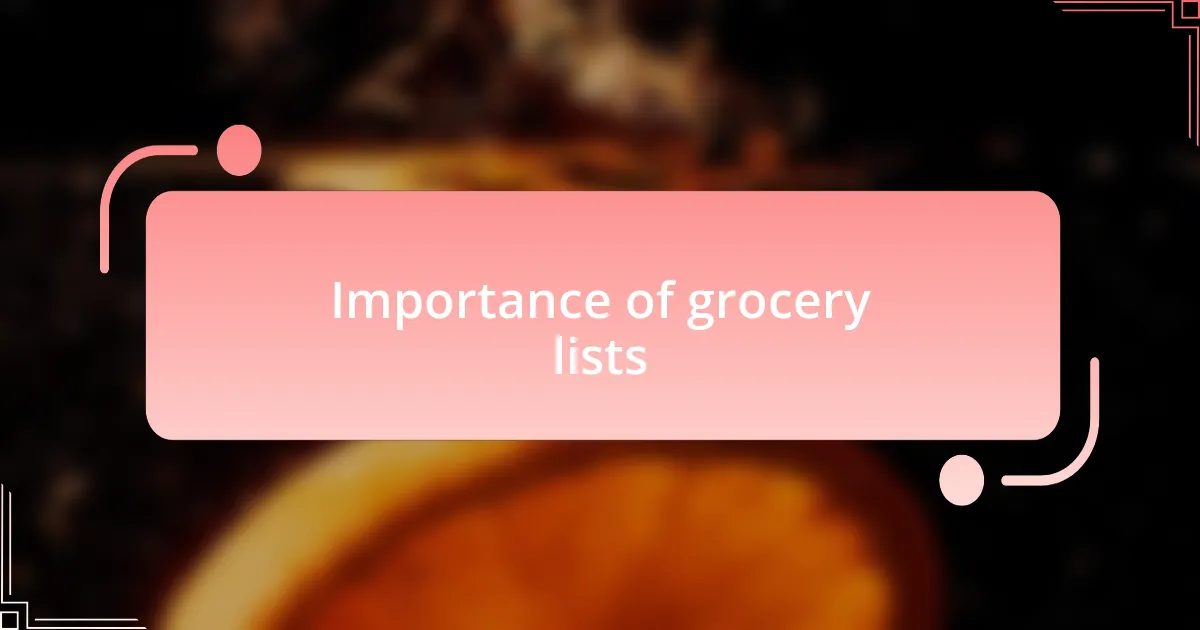Key takeaways:
- Healthy eating habits involve mindfulness, preparation, and recognizing food’s impact on well-being.
- Creating a grocery list helps avoid impulse buys, reduces stress in meal planning, and fosters accountability.
- Organizing the grocery list by categories and planning meals ahead streamlines shopping and boosts efficiency.
- Personalizing the grocery list to fit dietary needs and family preferences enhances engagement and satisfaction.

Understanding healthy eating habits
Understanding healthy eating habits is not just about following strict diets but involves developing a balanced relationship with food. When I began paying attention to how certain foods made me feel, I discovered that my energy levels and mood significantly improved with whole grains and fresh vegetables. Does food truly affect your day-to-day feelings? Absolutely—what we eat can shape our overall well-being.
I often think about how convenient it is to reach for unhealthy snacks, but I’ve learned that preparation plays a crucial role in healthy eating. By keeping my kitchen stocked with nutritious options and planning meals ahead, I’ve turned healthy eating from a chore into a rewarding experience. Have you ever felt satisfaction from cooking a meal from scratch? That sense of accomplishment ingrains a deeper appreciation for what we nourish ourselves with.
Another aspect I’ve come to realize is the importance of mindfulness while eating. When I sit down for a meal without distractions, I savor every bite, leading me to feel fuller on less food. It’s fascinating how simply paying attention can transform the way we perceive our hunger cues and enhance our dining experience. What if we all took just a moment to slow down and appreciate our meals? Wouldn’t that revolutionize our connection to food?

Importance of grocery lists
Creating a grocery list might seem mundane, but I’ve found it to be a game-changer when it comes to making healthier choices. When I take the time to jot down what I need before heading to the store, I not only save money but also avoid impulse buys of unhealthy snacks or processed foods. Have you ever wandered the aisles aimlessly, only to leave with a cart full of items that don’t support your health goals? I know I have, and those moments remind me of the importance of being intentional about my purchases.
Moreover, grocery lists can reduce the stress of meal planning. I remember the overwhelming feeling of staring into an empty fridge, wondering what I could possibly make for dinner. Now, I find that having a well-thought-out list allows me to visualize my meals for the week. It’s almost like I’m crafting a little roadmap for my nutrition. When I see those whole foods and fresh ingredients on the list, I feel excited about the meals waiting to be prepared. Isn’t it funny how a simple piece of paper can transform the cooking process into something enjoyable rather than a last-minute scramble?
Lastly, grocery lists foster accountability. When I write down what I need, I’m also committing to myself to stick to my healthy eating goals. I often turn to my list as a reminder of my intentions when I feel tempted to stray. It brings me a sense of purpose, knowing that I’m actively participating in my health journey. Have you noticed how writing things down can shift your mindset and help you stay on track? For me, it’s a small yet powerful step towards cultivating a healthier lifestyle.

Choosing healthy food options
Choosing healthy food options is all about making mindful decisions in the grocery store. I’ve experienced the difference it makes to prioritize whole foods, like fresh fruits and vegetables, over processed items. Have you ever noticed how vibrant produce can brighten your mood as you shop? I often feel energized just by being around all those colors and textures.
When I pick items, I now focus on their nutritional benefits. For example, incorporating lots of leafy greens into my cart not only boosts my energy but also ensures I’m getting essential vitamins. I remember when I used to skip these in favor of quicker options, but now, I savor the flavors of homemade salads, knowing I’m fueling my body right. Isn’t it rewarding to know that what you’re choosing directly impacts your health?
Another tip I’ve discovered is to read labels carefully. I used to glance at them without really understanding what the numbers meant. But once I took the time to learn about ingredients and nutritional content, it transformed my shopping experience. Now, I find myself gravitating toward items that are lower in added sugars and high in fiber. What little shifts have you made in your grocery shopping habits? I’m curious to hear about the changes that have worked for you!

Organizing your grocery list
When organizing your grocery list, I recommend grouping items by category. For instance, placing all the pantry staples like grains, canned goods, and spices together can significantly streamline your shopping trip. I’ve found that when I categorize my list, it saves me time and reduces the temptation to stray down aisles I don’t need to visit. Does anyone else feel that pull towards snacks during their grocery runs?
Another strategy I’ve embraced is to plan meals for the week ahead before I even draft my list. This practice not only ensures I buy exactly what I need but also sabotages any last-minute impulse buys I might regret later. I vividly remember a week when I didn’t plan properly; I ended up with a refrigerator full of random items and no cohesive meals. Reflecting on it, I realized how much I appreciated a clear plan that catered to nourishing meals without the guesswork.
Lastly, using a digital app to keep track of my grocery list has been a game changer. I can add items as I think of them and even share my list with family members if we’re cooking together. The few seconds it takes to enter an item on my phone saves me from the chaos of forgotten ingredients. How do you keep track of your grocery needs? I bet there are some fantastic tools out there that could help simplify the process.

Personalizing your grocery list
When it comes to personalizing your grocery list, I’ve discovered that knowing your dietary preferences and restrictions is essential. For example, because I have a sensitive stomach, I’m meticulous about avoiding certain ingredients like dairy or gluten. Tailoring your list according to what works best for your body not only impacts your health but also allows you to enjoy the foods you love without worry—what could be better than that?
Another facet of personalization relates to involving the whole family in the grocery planning process. I often ask my kids what fruits or veggies they’d like for the week. When they see their choices on the list, they’re more excited to eat them! It’s a small joy that makes grocery shopping feel inclusive and fun—who knew that asking for input could create such family engagement?
Lastly, I’ve started to link my grocery list to my mood for the week. Some days I crave hearty comfort foods, while others I feel like light salads. By acknowledging these moods, my grocery list transforms into a reflection of my current feelings and desires. Have you ever noticed how your cravings can shift from one day to the next? Personalizing my grocery list this way not only satisfies my palate but also nurtures my emotional well-being.